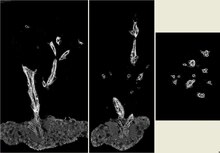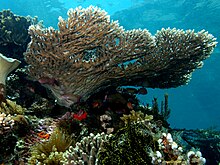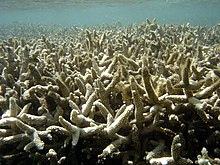Acropora
| Acropora | ||||||||||||
|---|---|---|---|---|---|---|---|---|---|---|---|---|

|
||||||||||||
| Systematics | ||||||||||||
|
||||||||||||
| Scientific name | ||||||||||||
| Acropora | ||||||||||||
| Oken , 1815 |
Acropora is the most species-rich genus of hard corals (Scleractinia).
While there are only three species in the Caribbean and the acropores around Hawaii are missing, the Australian hard coral specialist Veron gives 73 species for eastern Australia alone. The exact number of species in the entire Indo-Pacific is unknown, as there are many forms due to the networked evolution of this genus, the species status of which cannot be determined.
features
The polyps of the acropores are only one to three millimeters long. A large polyp at the end of each branch is characteristic. The terminal polyps also often have a special color and give the mostly brownish coral colony color. The axial polyps at the end of the branches have six tentacles, the radial polyps have twelve tentacles that they stick out at night to catch plankton .
In German, the acropores are often called antler corals or table corals, depending on their growth form. Like most other hard corals, they live in a symbiotic relationship with small algae ( zooxanthellae ), which supply the acropores with nutrients. The acropores are therefore dependent on bright locations.
Acropores dominate the reefs in many places and form real monocultures . They grow very quickly and make up an estimated 25% of the reef formation. In Barbados it has in Acropora cervicornis found an annual increase of 26 centimeters. While the flower animals grow in the shallow water and on the reef roofs mostly in the shape of a bush or antler, they often form table-shaped sticks on the reef slopes and grow horizontally outwards in order to catch as much light as possible.
species
Subgenus Isopora
- Acropora brueggemanni (Brook, 1893)
- Acropora cuneata (Dana, 1846)
- Acropora palifera (Lamarck, 1816)
Acropora subgenus
-
Acropora humilis group
- Acropora humilis (Dana, 1846)
- Acropora gemmifera (Brook, 1892)
- Acropora monticulosa (Brueggemann, 1879)
-
Acropora lovelli group
- Acropora bushyensis Veron & Wallace, 1984
- Acropora glauca (Brook, 1893)
- Acropora lovelli Veron & Wallace, 1984
- Acropora verweyi Veron & Wallace, 1984
-
Acropora robusta group
- Acropora danai (Milne-Edwards & Haime, 1860)
- Acropora listeri (Brook, 1893)
- Acropora nobilis (Dana, 1846)
- Acropora palmerae Wells, 1954
- Acropora polystoma (Brook, 1891)
- Acropora robusta (Dana, 1846)
-
Acropora formosa group
- Acropora acuminata (Verrill, 1864)
- Acropora abrolhosensis Veron, 1985
- Acropora formosa (Dana, 1846)
- Acropora grandis (Brook, 1892)
- Acropora valenciennesi (Milne-Edwards & Haime, 1860)
-
Acropora horrida group
- Acropora austera (Dana, 1846)
- Acropora horrida (Dana, 1846)
- Acropora kirstyae Veron & Wallace, 1984
- Acropora microphthalma (Verrill, 1869)
- Acropora tortuosa (Dana, 1846)
- Acropora vaughani Wells, 1954
-
Acropora aspera group
- Acropora aspera (Dana, 1846)
- Acropora millepora (Ehrenberg, 1834)
- Acropora pulchra (Brook, 1891)
-
Acropora selago group
- Acropora dendrum (Bassett-Smith, 1890)
- Acropora donei Veron & Wallace, 1984
- Acropora selago (Studer, 1878)
- Acropora tenuis (Dana, 1846)
- Acropora yongei Veron & Wallace, 1984
-
Acropora hyacinthus group, table corals
- Acropora anthocercis (Brook, 1893)
- Acropora cytherea (Dana, 1846)
- Acropora hyacinthus (Dana, 1846)
- Acropora microclados (Ehrenberg, 1834)
- Acropora paniculata Verrill, 1902
- Acropora spicifera (Dana, 1846)
-
Acropora latistellata group
- Acropora aculeus (Dana, 1846)
- Acropora azurea Veron & Wallace, 1984
- Acropora latistella (Brook, 1892)
- Acropora nana (Studer, 1878)
- Acropora sabulata (Dana, 1846)
-
Acropora nasuta group
- Acropora cerealis (Dana, 1846)
- Acropora lutkeni Crossland, 1952
- Acropora nasuta (Dana, 1846)
- Acropora secale (Studer, 1878)
- Acropora valida (Dana, 1846)
-
Acropora divaricata group
- Acropora clathrata (Brook, 1891)
- Acropora divaricata (Dana, 1846)
-
Acropora echinata group
- Acropora carduus (Dana, 1846)
- Acropora echinata (Dana, 1846)
- Acropora elseyi (Brook, 1892)
- Acropora longicyathus (Milne-Edwards & Haime, 1860)
- Acropora subglabra (Brook, 1891)
-
Acropora loripes group
- Acropora caroliniana Nemenzo, 1976
- Acropora chesterfieldensis Veron & Wallace, 1984
- Acropora granulosa (Milne-Edwards & Haime, 1860)
- Acropora loripes (Brook, 1892)
- Acropora willisae Veron & Wallace, 1984
-
Acropora florida group
- Acropora florida (Dana, 1846)
- Acropora sarmentosa (Brook, 1892)
- Caribbean group
- Deer antler coral ( Acropora cervicornis ) (Lamarck, 1816)
- Elk antler coral ( Acropora palmata ) (Lamarck, 1816)
- Acropora prolifera (Lamarck, 1816)
-
incertae sedis
- Acropora abrotanoides (Lamarck)
- Acropora akajimensis Veron, 1990
- Acropora arabensis Hodgson & Carpenter, 1996
- Acropora awi Wallace & Wolstenholme, 1998
- Acropora batunai Wallace, 1997
- Acropora branchi Riegl, 1995
- Acropora cardenae Wells, 1986
- Acropora echinata (Dana, 1846)
- Acropora convexa
- Acropora copiosa Nemenzo, 1967
- Acropora crassa (Milne-Edwards & Haime, 1860)
- Acropora crateriformis (Gardiner, 1898)
- Acropora cymbicyathus (Brook)
- Acropora delicatula (Brook)
- Acropora derawaensis Wallace, 1997
- Acropora desalwii Wallace, 1994
- Acropora digitifera (Dana, 1846)
- Acropora diversa (Brook)
- Acropora elegans (Milne-Edwards & Haime, 1860)
- Acropora eurystoma (Klunzinger, 1879)
- Acropora exquisita Nemenzo, 1971
- Acropora halmaherae Wallace & Wolstenholme, 1998
- Acropora hemprichii (Ehrenberg, 1834)
- Acropora hoeksemai Wallace, 1997
- Acropora indiana Wallace, 1994
- Acropora indonesia Wallace, 1997
- Acropora insignis Nemenzo, 1967
- Acropora intermedia (Brook, 1891)
- Acropora irregularis (Brook, 1892)
- Acropora jacquelinae Wallace, 1994
- Acropora kosurini Wallace, 1994
- Acropora loisetteae Wallace, 1994
- Acropora lokani Wallace, 1994
- Acropora magnifica Nemenzo, 1971
- Acropora mirabilis Quelch, 1886
- Acropora mossambica Riegl, 1995
- Acropora multiacuta Nemenzo, 1967
- Acropora natalensis Riegl, 1995
- Acropora ocellata (Klunzinger, 1879)
- Acropora parilis Quelch, 1886
- Acropora pharaonis (Milne-Edwards & Haime, 1860)
- Acropora plumosa Wallace & Wolstenholme, 1998
- Acropora pocilloporina Wallace, 1994
- Acropora pruinosa (Brook, 1893)
- Acropora rambleri Bassett-Smith, 1890
- Acropora reticulata (Brook, 1893)
- Acropora rosaria (Dana, 1846)
- Acropora rudis (Rehberg, 1892)
- Acropora russelli Wallace, 1994
- Acropora samoensis (Brook, 1891)
- Acropora schmitti Wells, 1950
- Acropora sekiseiensis Veron, 1990
- Acropora simplex Wallace & Wolstenholme, 1998
- Acropora solitaryensis Veron & Wallace, 1984
- Acropora sordiensis Riegl, 1995
- Acropora splendida Nemonzo
- Acropora squarrosa (Ehrenberg, 1834)
- Acropora stoddarti Pillai & Scheer, 1976
- Acropora striata (Verrill, 1866)
- Acropora subulata (Dana, 1846)
- Acropora suharsonoi Wallace, 1994
- Acropora sukarnoi Wallace, 1997
- Acropora surculosa (Dana, 1846)
- Acropora tanegashimensis Veron, 1990
- Acropora tenella (Brook, 1892)
- Acropora teres (Verrill, 1866)
- Acropora togianensis Wallace, 1997
- Acropora torihalimeda Wallace, 1994
- Acropora tumida Verrill, 1866
- Acropora turaki Wallace, 1994
- Acropora variabilis (Klunzinger, 1879)
- Acropora wallacea Veron, 1990
threat
Like other hard coral species , Acropora are threatened by the permanent warming and acidification of the oceans caused by human-made global warming through " coral bleaching ".
Aquarium keeping
Acropores can also be grown in well-maintained saltwater aquariums . If the water conditions are good, you can achieve length increases of 16 centimeters per year. They can easily be artificially propagated by fragmenting larger colonies. In the meantime there are many coral breeders who multiply acropores and try to keep shapes as colorful as possible. Today it is no longer necessary to import acropores from coral reefs.
literature
- Julian jump: corals. Dähne Verlag, 2000, ISBN 3-921684-87-0
- SA Fosså, AJ Nilsen: Coral reef aquarium. Volume 4, Birgit Schmettkamp Verlag, Bornheim, ISBN 3-928819-05-4
- Erhardt / Moosleitner: Mergus Sea Water Atlas. Volume 2. Mergus-Verlag, Melle, 1997, ISBN 3-88244-112-7
- Erhardt / Baensch: Mergus Sea Water Atlas. Volume 4. Mergus-Verlag, Melle, 1998, ISBN 3-88244-023-6
- Erhardt / Baensch: Mergus Sea Water Atlas. Volume 5. Mergus-Verlag, Melle, 2000, ISBN 3-88244-115-1
Web links
- Coral Hub: Acropora
- The Corals of the Genus Acropora (en.)
- Acropores in the sea water dictionary (German)
- Integrated Taxonomic Information System Acropora Oken, 1815
Individual evidence
- ↑ Elizabeth M. Hemond, Stefan T. Kaluziak, Steven V. Vollmer: The genetics of colony form and function in Caribbean Acropora corals . In: BMC Genomics . tape 15 , no. 1 , December 17, 2014, doi : 10.1186 / 1471-2164-15-1133 , PMID 25519925 , PMC 4320547 (free full text).









